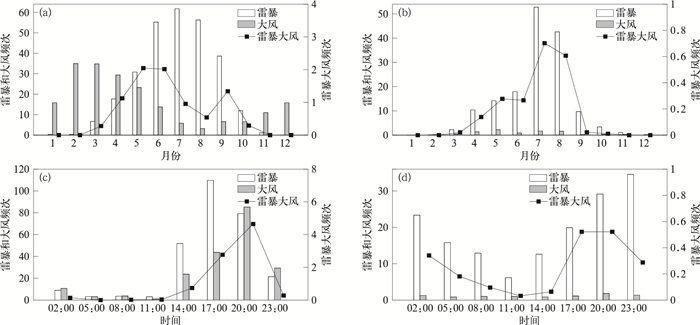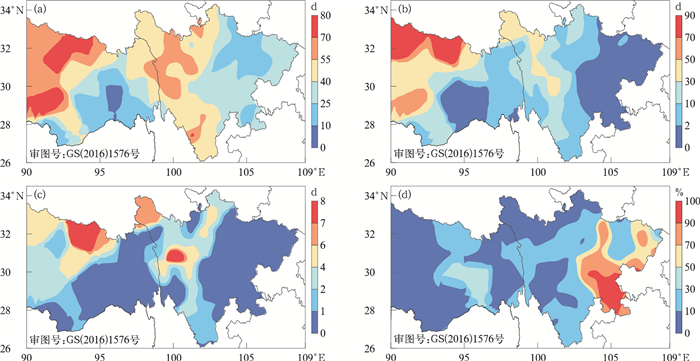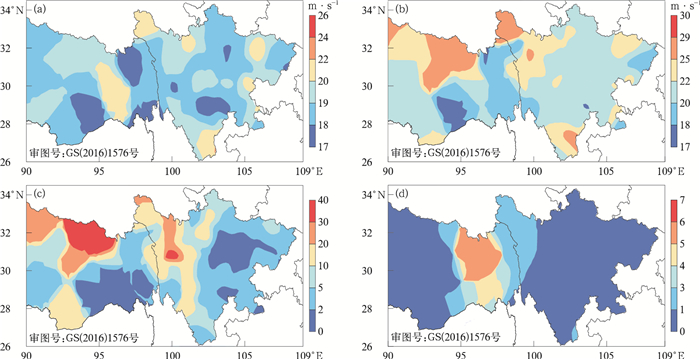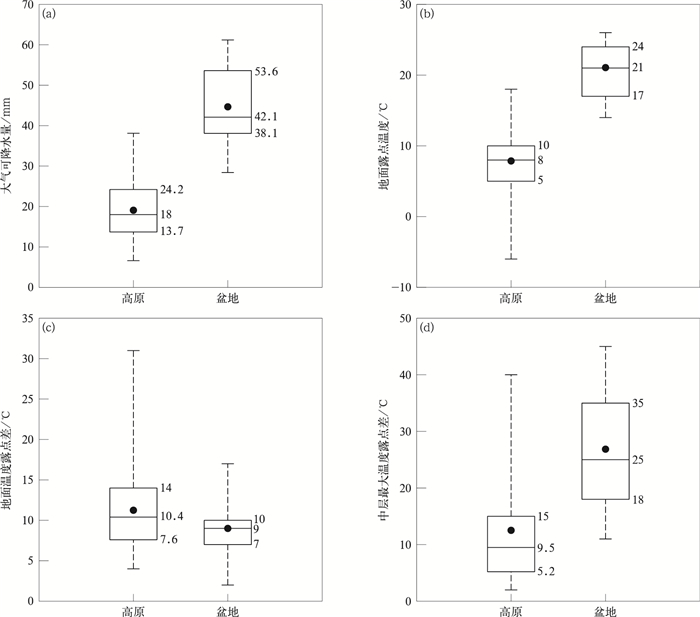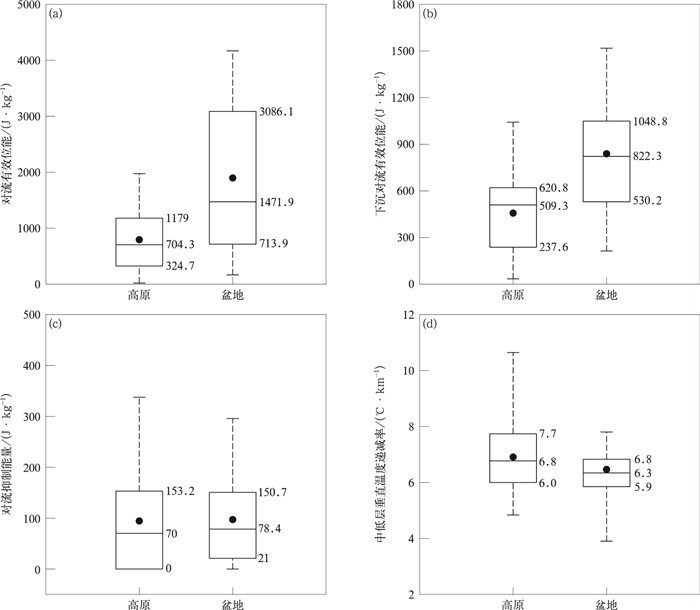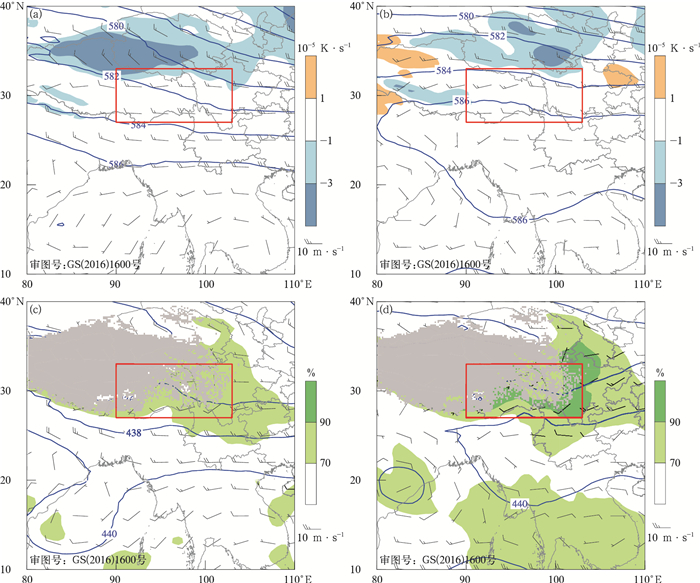Comparison of Characteristics and Environmental Factors of Thunderstorm Gales over the Sichuan-Tibet Region
-
摘要: 利用2010—2017年中国气象局重要天气报、地面观测和探空资料以及欧洲中期天气预报中心ERA-Interim再分析资料,对川藏地区雷暴大风的活动特征、环境因子和环流形势进行统计分析,并对其中高原(海拔高度不低于1 km)和盆地(海拔高度低于1 km)区域雷暴大风活动进行对比。结果表明:川藏高原区域雷暴大风频次呈5—6月和9月双峰型分布,主要发生在午后;盆地区域主要发生在夏季,午后和夜间均较活跃。高原站雷暴大风年平均频次约为2次/站,在雷暴和大风中分别约占4.5%和8%。盆地站年平均频次仅为0.4次/站,雷暴中仅占1.5%,但在大风中约占60%。高原站雷暴大风的中低层环境温度递减率较大,一般呈上湿下干的逆湿垂直结构;而盆地站雷暴大风通常具有上干下湿的垂直结构。分别对5—6月和9月高原站雷暴大风两个峰值时段的环流形势进行合成分析,发现5—6月受高空西风槽影响,中层有弱冷平流侵入,高层位于高空急流入口区右侧,环境垂直风切变较大;而9月受副热带高压边缘影响,中高层较干,低层暖湿气流明显。这些均有利于雷暴大风发生。Abstract: Characteristics, environmental factors and synoptic situations of thunderstorm gales over the Sichuan-Tibet Region from 2010 to 2017 are analyzed based on significant weather report, surface observations and sounding data from China Meteorological Administration and ERA-Interim reanalysis data from European Centre for Medium-Range Weather Forecasts(ECMWF). Distinct properties are revealed through comparison of characteristics and environmental parameters of thunderstorm gales over highland(1 km above sea level) and basin(1 km below sea level). Results show that thunderstorm gales occur over the highland during a full year except winter, with two peaks in May-June and September, respectively. Their diurnal variation shows a major peak at 2000 BT. However, thunderstorm gales over the basin are active both in the afternoon and in the evening mainly in summer. The annual station-averaged frequency of thunderstorm gales over the highland is about 2 times per station, proportions of which to thunderstorms and gales are about 4.5% and 8%, respectively. It is only 0.4 times per station for thunderstorm gales over the basin, which account for 1.5% of the thunderstorms but 60% of gales. The atmospheric water vapor content, convective available potential energy and downdraft convective potential energy over the highland are significantly lower than those over the basin. The mean vertical temperature lapse rate in the middle and lower troposphere over the highland is larger than that over the basin. Usually, there is a shallow moist layer in the middle troposphere overlaid on a drier air layer over the highland. However, there is usually significant dry air in the middle troposphere and a moist layer at low level over the basin. Synoptic situations of thunderstorm gales over the Sichuan-Tibet Region are composited during two peaks in May-June and September, respectively. During May and June, the vertical wind shear of the environment is strong, with the middle level affected by a westerly trough transporting weak cold advection at 500 hPa, and the upper level located on the right side of a jet entrance at 200 hPa. However, in September, the middle level over the Sichuan-Tibet Region is at the north edge of subtropical high pressure at 500 hPa, with significant dry air in the mid-upper troposphere and remarkable warm moist air flow at low level. Though synoptic situations are different in two seasons, both of them can provide favorable condition to the formation of thunderstorm gales.
-
图 2 2010—2017年雷暴、大风和雷暴大风站点平均频次及雷暴大风分别占雷暴和大风比例
(a)高原站频次逐年变化,(b)盆地站频次逐年变化,(c)高原站比例逐年变化,(d)盆地站比例逐年变化
Fig. 2 Station-averaged frequency of thunderstorms, gales and thunderstorm gales with proportion of thunderstorm gales to thunderstorms and gales during 2010-2017
(a)annual frequency over the highland, (b)annual frequency over the basin, (c)annual proportion over the highland, (d)annual proportion over the basin
图 3 2010—2017年站点平均的雷暴、大风和雷暴大风频次
(a)高原站逐月变化,(b)盆地站逐月变化,(c)高原站日变化,(d)盆地站日变化
Fig. 3 Station-averaged frequency of thunderstorms, gales and thunderstorm gales during 2010-2017
(a)monthly variation over the highland, (b)monthly variation over the basin, (c)diurnal variation over the highland, (d)diurnal variation over the basin
图 5 2010—2017年雷暴大风强度空间分布
(a)平均风速,(b)最大风速,(c)风速为17~24 m·s-1的累计总频次,(d)风速大于等于25 m·s-1的累计总频次
Fig. 5 Spatial distributions of thunderstorm gale intensity during 2010-2017
(a)mean wind speed, (b)maximum wind speed, (c)total frequency with wind speeds between 17 and 24 m·s-1, (d)total frequency with wind speed no less than 25 m·s-1
图 6 2010—2017年川藏地区雷暴大风水汽参数(盒须图最高和最低线段分别为最大值和最小值,盒线段从上到下依次对应第75,50和25百分位值,对应数值在右侧标出,点为样本平均值)
(a)可降水量, (b)地面露点温度, (c)地面温度露点差, (d)中层最大温度露点差
Fig. 6 Water vapor parameters in the Sichuan-Tibet Region during 2010-2017 (the top and bottom whiskers are the maximum and minimum values, lines inside the boxes from top to bottom correspond to the 75th, 50th and 25th percentile, respectively, with values marked on the right, black dots denote mean values)
(a)precipitable water, (b)surface dew point temperature, (c)surface dew point depression, (d)midlevel maximum dew point depression
图 7 2010—2017年川藏地区雷暴大风热力参数(盒须图最高和最低线段分别为最大值和最小值,盒线段从上到下依次对应第75,50和25百分位值,对应数值在右侧标出,点为样本平均值)
(a)对流有效位能, (b)下沉对流有效位能, (c)对流抑制能量, (d)中低层垂直温度递减率
Fig. 7 Thermal parameters in the Sichuan-Tibet Region during 2010-2017 (the top and bottom whiskers are the maximum and minimum values, lines inside boxes from top to bottom correspond to the 75th, 50th and 25th percentile, respectively, with values marked on the right, black dots denote the mean values)
(a)convective available potential energy, (b)downdraft convective available potential energy, (c)convective inhibition, (d)vertical temperature lapse rate at low level
图 8 2010—2017年川藏高原站雷暴大风日平均合成高度场(等值线,单位:dagpm)和风场(风羽,单位:m·s-1)
(红色方框为研究区域,图 8a和图 8b中填色为温度平流,图 8c和图 8d中填色为相对湿度)
(a)5—6月500 hPa,(b)9月500 hPa,(c)5—6月600 hPa,(d)9月600 hPaFig. 8 Composited geopotential height(the contour, unit:dagpm) and wind(the barb, unit:m·s-1) of thunderstorm gale days over the Sichuan-Tibet highland during 2010-2017(the shaded denotes temperature advection in Fig. 8a and Fig. 8b, and relative humidity in Fig. 8c and Fig. 8d)
(a)500 hPa in May-Jun, (b)500 hPa in Sep, (c)600 hPa in May-Jun, (d)600 hPa in Sep
-
[1] 郑永光, 陶祖钰, 俞小鼎.强对流天气预报的一些基本问题.气象, 2017, 43(6):641-652. http://d.old.wanfangdata.com.cn/Periodical/qx201706001 [2] 付桂琴, 曹欣.雷雨大风与河北电网灾害特征分析.气象, 2012, 38(3):353-357. [3] 段亚鹏, 王东海, 刘英."东方之星"翻沉事件强对流天气分析及数值模拟.应用气象学报, 2017, 28(6):666-677. doi: 10.11898/1001-7313.20170603 [4] 冯晋勤, 刘铭, 蔡菁.闽西山区"7.22"极端降水过程中尺度对流特征.应用气象学报, 2018, 29(6):748-758. doi: 10.11898/1001-7313.20180610 [5] 周福, 蒋璐璐, 涂小萍, 等.浙江省几种灾害性大风近地面阵风系数特征.应用气象学报, 2017, 28(1):119-128. doi: 10.11898/1001-7313.20170111 [6] 李耀东, 高守亭, 刘健文.对流能量计算及强对流天气落区预报技术研究.应用气象学报, 2004, 15(1):10-20. http://qikan.camscma.cn/jamsweb/article/id/20040102 [7] 陈淑琴, 章丽娜, 俞小鼎, 等.浙北沿海连续3次飑线演变过程的环境条件.应用气象学报, 2017, 28(3):357-368. doi: 10.11898/1001-7313.20170309 [8] 高晓梅, 俞小鼎, 王令军, 等.山东半岛两次海风锋引起的强对流天气对比.应用气象学报, 2018, 29(2):245-256. doi: 10.11898/1001-7313.20180210 [9] 唐文苑, 周庆亮, 刘鑫华, 等.国家级强对流天气分类预报检验分析.气象, 2017, 43(1):67-76. http://d.old.wanfangdata.com.cn/Periodical/qx201701007 [10] Yang X, Sun J, Zheng Y.A 5-yr climatology of severe convective wind events over China.Wea Forecasting, 2017, 32(4):1289-1299. http://www.wanfangdata.com.cn/details/detail.do?_type=perio&id=8882a8bbdbf72700417d955d0b516058 [11] Parker M D, Johnson R H.Organizational modes of midlatitude mesoscale convective systems.Mon Wea Rev, 2000, 128(10):3413-3436. doi: 10.1175-1520-0493(2001)129-3413-OMOMMC-2.0.CO%3b2/ [12] Meng Z Y, Yan D C, Zhang Y J.General features of squall lines in East China.Mon Wea Rev, 2013, 141(5):1629-1647. http://cn.bing.com/academic/profile?id=1e2aa755ffa0afa1ba6c69aaba0422e0&encoded=0&v=paper_preview&mkt=zh-cn [13] Schoen J M, Ashley W S.A climatology of fatal convective wind events by storm type.Wea Forecasting, 2011, 26(1):109-121. http://www.wanfangdata.com.cn/details/detail.do?_type=perio&id=49160d97e4e4664a82ae11a1bff99b9c [14] Smith B, Castellanos T, Winters A, et al.Measured severe convective wind climatology and associated convective modes of thunderstorms in the contiguous United States, 2003-09.Wea Forecasting, 2013, 28(1):229-236. http://www.wanfangdata.com.cn/details/detail.do?_type=perio&id=d0d345e10d5013c0ba36490e1c1b52a0 [15] Wang J K, Ford T W, Quiring S M.Distinguishing between unorganized and organized convection when examining land-atmosphere relationships.J Appl Meteor Climatol, 2015, 54(11):2229-2243. http://www.wanfangdata.com.cn/details/detail.do?_type=perio&id=da3530f0d80da04495db15ae1944f80a [16] 俞小鼎, 周小刚, 王秀明.雷暴与强对流临近天气预报技术进展.气象学报, 2012, 70(3):311-337. http://d.old.wanfangdata.com.cn/Periodical/nfny201823076 [17] Markowski P M, Richardson Y P.Mesoscale Meteorology in Midlatitudes.Hoboken, Wiley-Blackwell, 2010:245-260. [18] 杨晓霞, 胡顺起, 姜鹏, 等.雷暴大风落区的天气学模型和物理量参数研究.高原气象, 2014, 33(4):1057-1068. http://d.old.wanfangdata.com.cn/Periodical/gyqx201404019 [19] 孔锋, 郭君, 王一飞, 等.近56年来中国雷暴日数的时空分异特征.灾害学, 2018, 33(3):87-95. http://d.old.wanfangdata.com.cn/Periodical/zhx201803017 [20] 孙继松.气流的垂直分布对地形雨落区的影响.高原气象, 2005, 24(1):62-69. http://d.old.wanfangdata.com.cn/Periodical/gyqx200501010 [21] 肖现, 陈明轩, 高峰, 等.弱天气系统强迫下北京地区对流下山演变的热动力机制.大气科学, 2015, 39(1):100-124. http://d.old.wanfangdata.com.cn/Periodical/daqikx201501009 [22] 尤伟, 臧增亮, 潘晓滨, 等.夏季青藏高原雷暴天气及其天气学特征的统计分析.高原气象, 2012, 31(6):1523-1529. http://d.old.wanfangdata.com.cn/Periodical/gyqx201206007 [23] 郑永光, 周康辉, 盛杰, 等.强对流天气监测预报预警技术进展.应用气象学报, 2015, 26(6):641-657. doi: 10.11898/1001-7313.20150601 [24] 严仕尧, 李昀英, 齐琳琳, 等.华北产生雷暴大风的动力热力综合指标分析及应用.暴雨灾害, 2013, 32(1):17-23. http://d.old.wanfangdata.com.cn/Periodical/hbqx201301003 [25] 杨新林, 孙建华, 鲁蓉, 等.华南雷暴大风天气的环境条件分布特征.气象, 2017, 43(7):769-780. http://d.old.wanfangdata.com.cn/Periodical/qx201707001 [26] 郭英莲, 孙继松.湖北三类组织形态强对流系统造成的地面强对流大风特征.大气科学, 2019, 43(3):483-497. http://d.old.wanfangdata.com.cn/Periodical/daqikx201903002 [27] Li M X, Zhang Q H, Zou T J, et al.Climatology of hail frequency and size in China, 1980-2015.J Appl Meteor Climatol, 2018, 57(4):875-887. http://www.wanfangdata.com.cn/details/detail.do?_type=perio&id=721da55b5e49e1092322de773a7214a9 [28] 地面气象观测业务技术规定.北京: 中国气象局, 2016. [29] 雷蕾, 孙继松, 魏东.利用探空资料判别北京地区夏季强对流的天气类别.气象, 2011, 37(2):136-141. http://d.old.wanfangdata.com.cn/Periodical/qx201102002 [30] 孔锋, 杨萍, 王品, 等.中国灾害性对流天气日数的时空变化特征.长江流域资源与环境, 2018, 27(11):2518-2528. http://d.old.wanfangdata.com.cn/Periodical/cjlyzyyhj201811013 [31] 张鸿发, 郭三刚, 张义军, 等.青藏高原强对流雷暴云分布特征.高原气象, 2003, 22(6):558-564. http://d.old.wanfangdata.com.cn/Periodical/gyqx200306005 [32] Yin S Q, Chen D, Xie Y.Diurnal variations of precipitation during the warm season over China.Inter J Climatol, 2009, 29(8):1154-1170. http://d.old.wanfangdata.com.cn/Periodical/dqkxjz-e201902003 [33] 王秀明, 周小刚, 俞小鼎.雷暴大风环境特征及其对风暴结构影响的对比研究.气象学报, 2013, 71(5):839-852. http://d.old.wanfangdata.com.cn/Periodical/qxxb201305004 [34] 方翀, 王西贵, 盛杰, 等.华北地区雷暴大风的时空分布及物理量统计特征分析.高原气象, 2017, 36(5):1368-1385. http://www.wanfangdata.com.cn/details/detail.do?_type=perio&id=gyqx201705020 [35] 高晓梅, 俞小鼎, 王令军, 等.鲁中地区分类强对流天气环境参量特征分析.气象学报, 2018, 76(2):196-212. http://www.wanfangdata.com.cn/details/detail.do?_type=perio&id=qxxb201802003 [36] 樊李苗, 俞小鼎.中国短时强对流天气的若干环境参数特征分析.高原气象, 2013, 32(1):156-165. http://d.old.wanfangdata.com.cn/Periodical/gyqx201301016 [37] 周明煜, 钱粉兰, 陈陟, 等.西藏高原斜压对流边界层风温湿廓线特征.地球物理学报, 2002, 45(6):773-783. [38] 孙继松, 陶祖钰.强对流天气分析与预报中的若干基本问题.气象, 2012, 38(2):164-173. http://d.old.wanfangdata.com.cn/Periodical/dtsj201621158 [39] 张翠华, 言穆弘, 董万胜, 等.青藏高原雷暴天气层结特征分析.高原气象, 2005, 24(5):741-747. http://d.old.wanfangdata.com.cn/Periodical/gyqx200505013 [40] 王秀明, 俞小鼎, 朱禾.NCEP再分析资料在强对流环境分析中的应用.应用气象学报, 2012, 23(2):139-146. http://qikan.camscma.cn/jamsweb/article/id/20120202 [41] Hurlbut M M, Cohen A E.Environments of northeast U.S. severe thunderstorm events from 1999 to 2009.Wea Forecasting, 2014, 29(1):3-22. http://www.wanfangdata.com.cn/details/detail.do?_type=perio&id=94d5c63123b037eeebe26c9db2fa9a3c [42] Jiang J, Fan M.Convective clouds and mesoscale convective systems over the Tibetan Plateau in summer.Chinese J Atmos Sci, 2002, 26(2):263-270. http://www.wanfangdata.com.cn/details/detail.do?_type=perio&id=daqikx200202012 [43] 马淑萍, 王秀明, 俞小鼎.极端雷暴大风的环境参量特征.应用气象学报, 2019, 30(3):292-301. doi: 10.11898/1001-7313.20190304 [44] 陈明轩, 王迎春.低层垂直风切变和冷池相互作用影响华北地区一次飑线过程发展维持的数值模拟.气象学报, 2012, 70(3):371-386. http://d.old.wanfangdata.com.cn/Periodical/qxxb201203004 [45] Yang X, Sun J.Organizational modes of severe wind-producing convective systems over north China.Adv Atmos Sci, 2018, 35(5):540-549. http://www.wanfangdata.com.cn/details/detail.do?_type=perio&id=dqkxjz-e201805006 [46] Hjelmfelt M R.Structure and life cycle of microburst outflows observed in Colorado.J Appl Meteor, 1988, 27(8):900-927. doi: 10.1175-1520-0450(1988)027-0900-SALCOM-2.0.CO%3b2/ [47] Wakimoto R M.Forecasting dry microburst activity over the high plains.Mon Wea Rev, 1985, 113(7):1131-1143. doi: 10.1175-1520-0493(1985)113-1131-FDMAOT-2.0.CO%3b2/ -


 设为首页
设为首页 加入收藏
加入收藏


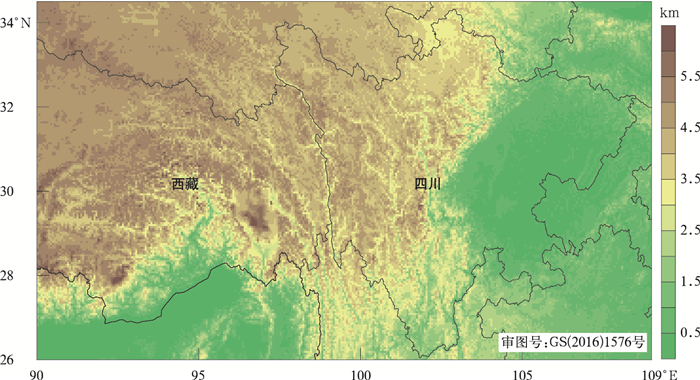
 下载:
下载:

